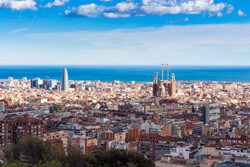
Without a doubt, one of Barcelona’s top attractions for tourists is admiring the city’s modernista architecture, and the works of Antoni Gaudí in particular. Architect and designer, Antoni Gaudi was at the forefront of the Art Nouveau movement in Spain. His work in Barcelona led to the creation of some of the city’s most notable landmarks. Gaudi was a pioneer in his field using color, texture, and movement in ways never before imagined. His works, both finished and uncompleted, stand as testimony to his genius.
The Picasso museum is a key reference for understanding the formative years of Pablo Picasso. The genius of the young artist is revealed through the 4,251 works that make up the permanent collection. Furthermore, the Picasso museum, opened in 1963, also reveals his deep relationship with Barcelona: an intimate, solid relationship that was shaped in his adolescence and youth, and continued until his death.
Barcelona’s biggest ornamental fountain, which was built in 1929 for the International Exhibition, offers a spectacular display of music, water acrobatics and lights which generate over 50 kinds of shades and hues. The Montjuic Magic Fountain has become one of Barcelona’s most popular attractions and is where the “Piromusical” is held, a true balletic spectacle of water and light. The fountain is located at the head of Avinguda Maria Cristina in the Montjuic neighborhood of Barcelona, below the Palau Nacional on the Montjuic mountain and near the Plaça d’Espanya and Poble Espanyol de Barcelona.
Strolling around the old city, and especially the Gothic quarter – next to the popular La Rambla – is a great way to get a feel for the town. Every corner is full of history and, from the old Jewish quarter, el Call, to the secluded medieval alleyways that define the neighbourhood, you’ll find charming little squares, streets or patios in many buildings that are open to the public, such as the historical archive of the city or the Roman Temple of Augustus. Squares not to miss are Plaça del Rei and Plaça Sant Felip Neri, a hauntingly silent spot with an emblematic fountain and church, in the walls of which can be seen the scars of heavy bombing from the Spanish civil war.
La Rambla, or “Las Ramblas”, as it is sometimes called, is Barcelona’s most famous boulevard. La Rambla starts at Plaza Catalunya and ends at the Monument of Columbus at the Port Vell harbour of Barcelona. Here you will not only find many interesting shops, restaurants and buildings but also street performers.
If there are no games during your visit, then book the stadium and museum tour. The Camp Nou stadium and FCB museum are among the most popular attractions in Barcelona attracting millions of visitors a year. Camp Nou also has the one of the largest Nike stores in Europe packed with Barca merchandise.
You can reach the Poble Espanyol, the Spanish village, at the foot of Montjuic by a replica of the gate of the Castilian city of Avila and then you experience the whole variety of Spanish culture on almost 50,000 m² metres. The Poble Espanyol is primarily an open-air museum, it shows replicas of characteristic houses from all regions of Spain, such as from Castile, Andalusion, Aragon, the Basque Country, Extremadura and of course from Catalonia. In some buildings craftsmen show their skills, such as in the Andalusian quarter in the glass blowers. The products can be bought in the shops. Similarly you get one’s money worth culinary wise in of the many restaurants. Even a flamenco stage is there.
The Tramvia Blau, which dates from 1901, is the survivor of the old Barcelona. It runs 1,276 metres up to the foot of the Tibidabo funicular, past Modernista and Noucentista buildings that give way to nature and splendid views of the city.
The journey to Tibidabo amusement park starts with a short train ride from the centre of Barcelona from there you will take the Tramvia Blau which takes you half way up the mountain. If you wish to go all the way to the top of Tibidabo, where the amusement park is situated, you will also need to catch a funicular train from the half way point. Once at the top of the mountain you will be rewarded with magnificent views of Barcelona, an amusement park for the kids, and the opportunity to visit a beautiful church at the summit of the mountain.
Barceloneta is the first of the Barcelona beaches and can therefore get quite busy during the summer months.
Metro stop “Barceloneta” (Yellow Line, L4). Turn right on leaving the metro and cross the main road, continue walking straight along Passeig de Joan de Borbo for about 10 minutes. You will see the marina area on your right as you walk.
Metro stop “Ciutadella Vila Olimpica” (Yellow Line, L4). Turn right on exiting the metro and walk towards the twin towers. 10 minutes walk from metro.
Metro stop “Poblenou” (Yellow Line, L4). You’ll have a 20 minutes walk from Poblenou metro station to Bella Beach. Although this is unofficially a nudist beach there are many people that go here that are not nude.
Sitges beach is outside Barcelona and you’ll need to catch a train from Sants station – journey time approximate 30 minutes.